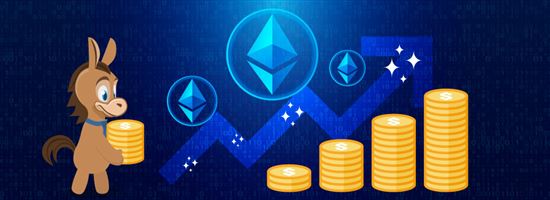How to Stake Ethereum
Staking Ethereum is a way to earn interest on this popular crypto asset. But how do you do it? Keep reading to find out.
 |
If you've been wondering what to do with your Ethereum, staking could be the answer.
In staking, you deposit your coins for a fixed period of time. Then, they're used by the network to validate transactions on the blockchain.
Best of all, you'll be rewarded with even more Ethereum.
So how do you start staking? And are there any risks? Find out how to stake your Ethereum and the potential risks to be aware of in this guide.
What is Staking?
Staking is a way of earning interest on your cryptocurrency by depositing it for a fixed period of time. Here's how it works:
One of the defining features of cryptocurrency is its independence from any centralized authority, like banks or payment processors.
Instead of relying on a central authority to record transactions, crypto records transactions on a public ledger that anyone can view—the blockchain.
With Bitcoin, verifying transaction is done through a "Proof of Work" (PoW) protocol commonly called mining.
The "Proof of Stake" protocol (PoS) is an alternative to mining used by cryptocurrencies like Ethereum.
Instead of requiring heavy processing power to earn the right to verify transactions, stakers earn the opportunity by depositing their coins for a period of time.
Validators are chosen randomly from the group of people who meet the staking requirements. They then earn rewards (interest) for verifying the next batch of transactions.
How to Stake Ethereum
 |
There are two main ways to stake Ethereum. The first is to do it yourself, and the second is to do it through an exchange. We'll talk about both.
Staking Ethereum Directly
Staking Ethereum yourself will involve a lot more work than staking through an exchange.
Becoming a full validator requires staking 32 ETH or more, an amount worth nearly $100k at time of writing. This can be achieved by joining a staking pool, where stakers work together to cross the minimum threshold.
To stake Ethereum directly, you'll need to set up a staking node. While we won't explain in complete detail here every step of the process of setting up a node, here's a look at some of the requirements you can expect.
Hardware: Ideally, you'll want dedicated hardware for your node to maximize efficiency and security. Different options vary in terms of usability, reliability, and cost.
Some potentially viable options include:
- New or Used Computer (laptop or desktop)
- NUC/mini PC/dapp node
- Server
- Raspberry Pi 4 8GB
- Avado
- Virtual Private Server
Hard drive
- At least 400GB of storage, with requirements potentially increasing over time
- 1TB or 2TB SSD storage is ideal
CPU and RAM
- Varies depending on client
- CPU with passmark score of at least 2,500; 6,000 is good; 7,075 or higher is best
- At least 16GB of RAM
Internet
- Stable 24/7 connection
- No throttling or caps
- Upload bandwidth of at least 700-800 MB per hour
Battery Backup: There are penalties for downtime when staking solo, so you'll want to avoid this if you can.
Client: You'll need to configure and run an Eth1 and Eth2 client (Windows/Linux/Mac). These include:
- Lighthouse: Speed and security-focused Ethereum 2.0 client
- Prysm: Usability, reliability, and security-focused Ethereum 2.0 client
- Nimbus: Mobile and embedded systems-focused Ethereum 2.0 client
- PegaSys Teku: Java-based Ethereum 2.0 client
Setting up a node at home can be a challenging process, and an expensive one as well, at least at current ETH prices. For those looking to learn more, there is a helpful Reddit community as well as detailed guides to be found at ethereum.org.
If you want to stake at home but don't have 32 ETH to do it with, you might look into one of the staking services listed at beaconcha.in. Different services have different requirements and varying fees.
Make sure to research them carefully before choosing as they've not been vetted by the platform.
if you start staking now. Withdrawals from the staking platform will depend on updates that have not been released at time of writing. Withdrawal of staked Ethereum will only be possible after the merge, which will mark the full switch of Ethereum to proof of stake instead of proof of work. This is expected to happen sometime in Q1 or Q2 2022.
Staking Ethereum through an Exchange
For most investors, the easiest path to staking Ethereum is through an exchange or similar crypto platform.
Most platforms that offer staking will take a percentage of your earnings in the form of fees. However, you may find it worth it for the flexibility it offers.
Staking through an exchange means you won't have to go through all the work of setting up and maintaining a staking node.
You avoid the external costs of hardware and electricity, and in some (but not all) cases, you can stop staking at any time.
Are There Risks to Staking Ethereum?
Like any investment, staking Ethereum isn't risk-free.
One of the biggest risks to Ethereum stakers comes from crypto's inherent volatility.
People have made money due to the price fluctuations that crypto experiences daily. But with staking, you may be locked into a fixed term that prevents you from selling your coins when you want to.
If the price drops suddenly, there may not be anything you can do to prevent a loss. This is especially true when it comes to Ethereum, since you likely won't be able to withdraw it until 2022.
For those staking on their own, there is a risk of slashing. This is a penalty taken from stakers deemed to be performing poorly, or worse, dishonestly, taken as a percentage of their funds.
Staking can also incur fees, especially for those using an exchange to do it. Seeking out lower fees is an excellent reason to shop around between exchanges before you choose a staking platform.
What are the benefits of staking?
Staking has several advantages over mining.
It is generally considered more efficient, offering quicker transaction times and lower fees to traders.
Staking uses far less energy because it isn't reliant on raw computing power, and thereby generates far less CO2 and electronic waste.
These are some of the reasons why Ethereum, which began as a proof of work-based cryptocurrency, introduced the option to stake with the launch of ETH2 in December 2020.
Staking a coin can also show that you believe it's a worthwhile investment. Since cryptocurrency is very dependent on public confidence, staking is good for the community as a whole.
Additionally, by taking your coins temporarily out of circulation, you may actually help increase the price of your cryptocurrency by increasing scarcity.
Bottom Line
Whether you're ready to dive into the technical process of setting up your own node, or you want to take the easy route of going through an exchange, there are lots of options for staking Ethereum—and plenty of good reasons to do it, too.
Beyond the obvious opportunity to earn money, you'll be doing your part to lower the impact of crypto on the climate, and benefitting the Ethereum community as well. If you're already holding ETH, staking it could positively impact the value of your coins.
Just pick your path and you'll be on your way to staking Ethereum in no time.
Jeremy Harshman is a creative assistant at CreditDonkey, a crypto comparison and reviews website. Write to Jeremy Harshman at jeremy.harshman@creditdonkey.com. Follow us on Twitter and Facebook for our latest posts.
|
|
| ||||||
|
|
|







